Curating at One World Trade Center is a plum assignment, but treacherous. To get it right, the Durst Organization (real estate heavyweights celebrating their centenary with 13 million square feet under management) and the Port Authority (notorious for its chronic tin ear in aesthetic matters) brought in dealer and deal-maker Asher Edelman of Edelman Arts, who set up the art leasing company Artemus to help him manage the task.
Even during construction, Edelman started commissioning site-specific paintings and a sculpture, including what is purported to be the largest painting in New York. The colorful whopper in the ground floor lobby is by José Parlá. It is joined by two more subtle paintings by Doug Argue, two knockout works by Abstract Expressionist Fritz Bultman, and, in the 64th-floor lobby, a suite of seven square paintings by Greg Goldberg along with a ripe new Bryan Hunt sculpture.
.
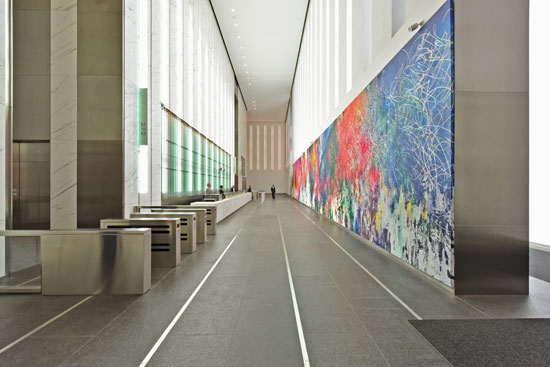
"Union of the Senses" by José Parlá, 2014. Acrylic, gesso, ink, enamel and plaster on fire rated MDF board, 14' 2.5" x 89' 5.5." Courtesy of Edelman Arts.
.
After a royal visit in December by Prince William and Kate and a preview for art scene A-listers in February, the public art collection can now be viewed by 30,000 or so daily visitors, some of them just settling into their new Condé Nast offices.
In almost any other office building in any world capital, the collection would be remarkable if not exactly triumphant, but 1WTC makes demands that test our faith in the power of art itself. That is just the sort of challenge that is a red cape in front of the horns of the audacious Edelman, a leading collector of contemporary art and antiquities from decades ago who went pro and runs a gallery near Union Square as well as the new, innovative art leasing concern.
He has courted controversy as a Wall Street “activist investor” (read “raider’), as an outspoken critic of the auction houses as “overreaching,” as the founder of a private museum in Switzerland where he curated the largest Robert Mapplethorpe exhibition ever, and as a professor in Columbia’s MBA program, which landed him on page one of the Times in the first week of the semester for offering his class a cash bonus if they presented a takeover target. (This once scandalous incentive is now common at Stanford.) Fortunately for 1 WTC and the Dursts, he has an elegant eye as well as balls.
The curatorial strategy leads with abstraction, using high color to counterpunch not just history but the bland, arctic expanses of white marble and sheetrock of the rhetorically styled “Freedom Tower.” Three of the four artists at the opening used the word “difficult” to describe the boring spaces in which the art had to be hung. Parla’s monumentally exuberant Union of the Senses (a 90-foot-long chromatic fantasy in acrylic, gesso, ink, enamel and plaster on board) is a high-decibel salsa soundtrack better suited to the Barclay’s Center arena, where he is also featured.
It echoes a notch too loudly in a Speer-like cavernous lobby so narrow you can barely step away to see it, although some of its layering rewards close looking. A more cerebral effect is offered by Doug Argue’s two cosmological paintings (Randomly Placed Exact Percentages and Isotropic), ambitious in scale yet delicate in touch. Like the coursing light of the illuminated square fountains in the memorial just north of the building, they flicker with the pulse of philosophical inquiry characteristic of his work. Arguably not the most apt choice for ramparts high above an elevator bank, where the hurried refrain of “hold the door” echoes, their embedded texts require close reading from a still point. It is a star turn on an international stage, though, for an artist who bears watching (including at the Venice Biennial starting in May).
.
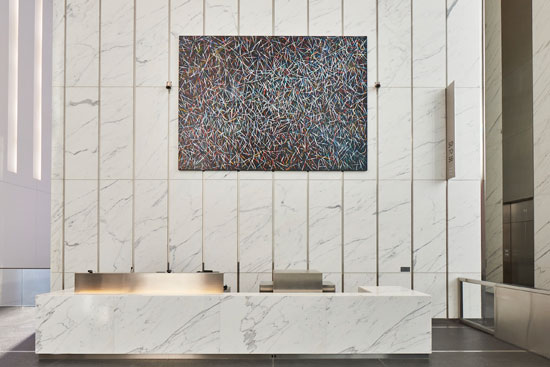
"Isotropic" by Doug Argue, 2009-2013. Oil on canvas, 9.5 x 13.5 inches. Courtesy of Edelman Arts.
.
The absolute highlight of the collection, packing the kind of lyric power that nearly redeems the prosaic architecture as well as the awful feng shui of the place, are the two big-hearted Bultman triptychs that unleash an operatic cri de coeur over the sterile typography of the chrome Condé Nast signage. Rescued from obscurity by Edelman in a recent exhibition and in this high-profile installation, Bultman is himself a story worthy of Vanity Fair.
.
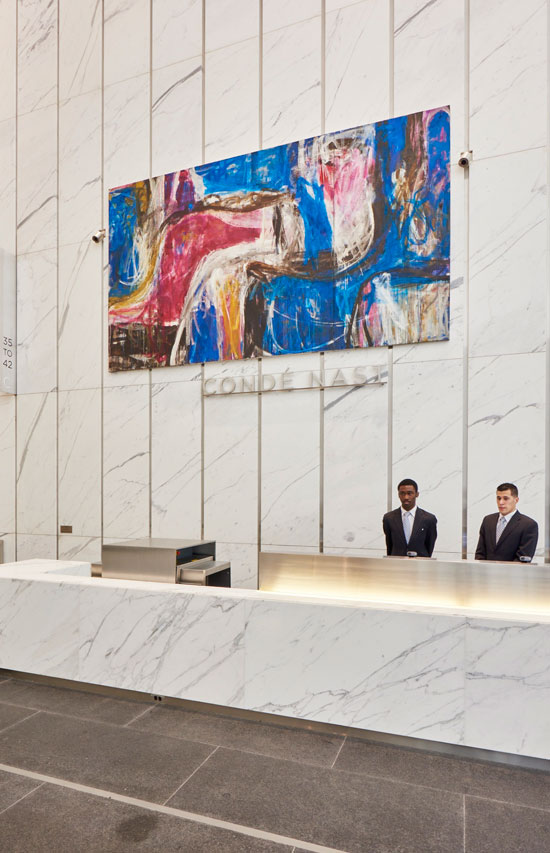
"Blue Triptych - Intrusion into the Blue" by Fritz Bultman, 1961. Oil on canvas, 96 x 168 inches. Courtesy of Edelman Arts.
.
Respected by Pollock and De Kooning, the favorite pupil of Hans Hofmann, best man at Robert Motherwell’s wedding to Helen Frankenthaler, literary fodder for his friend Tennessee Williams, Bultman was a star of the AbEx first generation. He skipped the photo shoot for the famous 1951 Irascibles group portrait for a trip to Europe, and this in part accounts for why he has not assumed his rightful position among those paint-slingers of New York’s titanic moment. Any viewer of Gravity of Nightfall and Blue Triptych can see his importance, even from too many feet behind the reception desk.
.
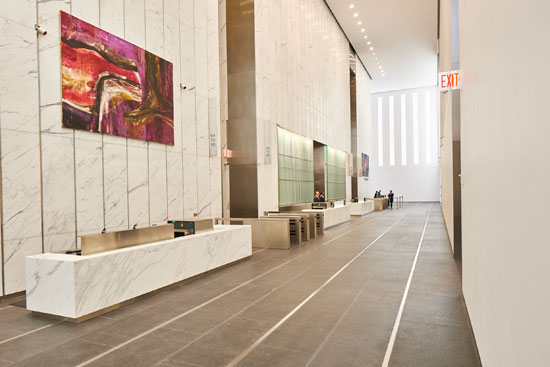
"Gravity of Nightfall" Fritz Bultman, 1961. Oil on canvas, 3 panels, 96 x 144 inches. Courtesy of Edelman Arts.
.
Among the many lessons Bultman learned from Hofmann, the building of a positive instead of recessive pictorial space is the compositional coup that makes these paintings so effective on the massive white marble walls. They project their brooding vision with a fullness that is as brilliant as the artist, a thinker (like Motherwell) whose reading embraced James Joyce, Hart Crane, Oswald Spengler and C.G. Jung. You can sense in the paintings that he would have comprehended the depth of significance of offering a painting in a place steeped in tragedy.
.
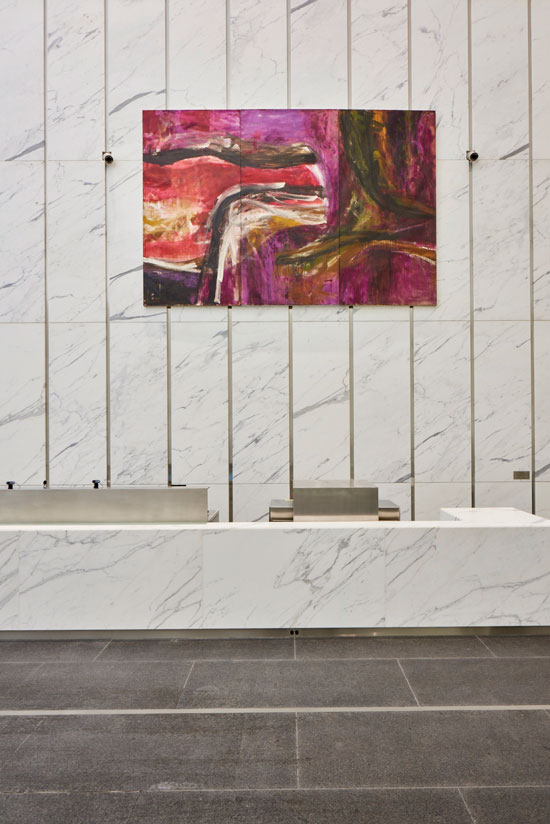
"Gravity of Nightfall" Fritz Bultman, 1961. Oil on canvas, 3 panels, 96 x 144 inches. Courtesy of Edelman Arts.
.
Bultman’s grandsons Tristan and Gwyther were on hand for the opening, and pointed out that their mother, Bethany, was a contributing editor at House and Garden, one of Condé Nast’s premier magazines. Long identified with his native New Orleans and the Provincetown arts scene in its heyday, the artist also lived on the Upper East Side in nearly daily contact with Mark Rothko, Barnett Newman, Richard Lindner and Giorgio Cavallon. “Friz has returned home,” Tristan observed, as he reminisced about playing in the Condé conference room as a child.
Up on floor 64 the aesthetic air thins. Goldberg’s seven brightly colored canvases gamely face a bank of picture windows with drop-dead views of midtown. Goldberg cased the room as raw space, and took as his tonic keys the primary colors (two gestural paintings are based on red, two on yellow and three on blue). “I punched up these really strong colors so the physical presence of the paintings would not get lost,” the artist remarked.
Bryan Hunt’s Axis Mundi is a slightly paunchy, purple version of the streamlined Brancusian airships for which he became known. Backlit, the translucent papery skin reveals an intriguing substructure of wooden girders, and the bulbous base is stylishly organic. The palette is glowing (the burgundy is in the same family as some of the warmer violets in the Bultman and Parla paintings below), and the effect is at least blood-warm (which cannot be said of the architecture).
.
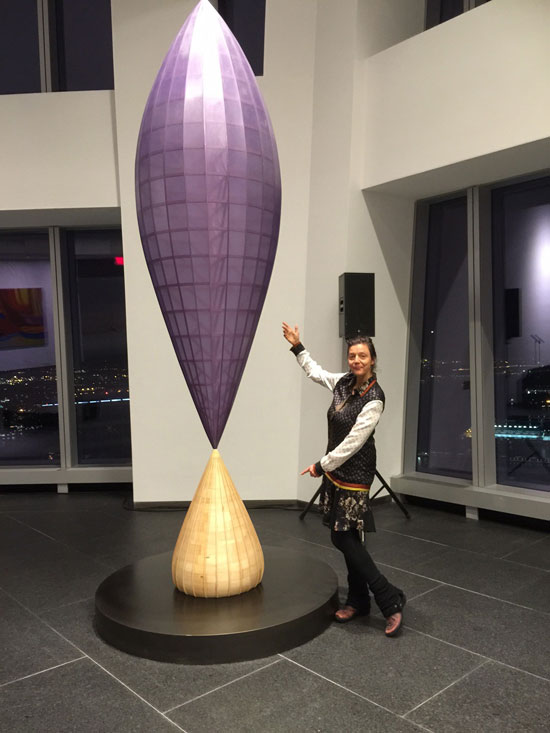
Anita Durst with "Axis Mundi" by Bryan Hunt, 2014. Wood, steel. polyester fabric, lacquer, 12.25 feet high by 2.5 feet diameter.
.
Hunt was cheered on at the opening by his friends and East End neighbors Eric Fischl (who, as some might recall, struck out on his own ill-advised Rodinesque cut at a 9/11 commemoration). Along with many major collectors and curators, Anita Durst, who chairs the board of the nonprofit Chashama, was also on hand as Edelman charmed the festive crowd, banging back Prosecco and canapes, with a brief recollection of walking along a wooden scaffolding in the unfinished sky lobby as he scoped out the project.
“I don’t like heights,” he admitted. “We wanted to accomplish something elegant and meaningful, a return to people looking at art, looking up from their devices.”
The dreadful qi of the place lingered unspoken. Abstraction (as in absolute music, by contrast with commemoration) is one way for aesthetics to make a stand against the curse of a place so weighted with disaster. Some art plays on the drama (a visit by this critic to Ai Wei Wei’s Alcatraz installation a week later brought home the difficult imbalance between artifice and real suffering). Bleaching a site in monumental white stone is not the answer, either, as a visit to Tiananmen Square can prove.
Just outside the windows, the usually magical Santiago Calatrava’s over-budget transit building looked expensive but just pretty, and a spotlit Jeff Koons balloon piece in the plaza of 7 WTC (predating Edelman’s project) was banal to the point of being an insult. The trouble is that for those who lost somebody at the World Trade Center, only the power of truly great art (the Bultman paintings?) stood a chance.
As Shakespeare asked in sonnet 65, “How with this rage can beauty hold a plea, whose action is no stronger than a flower?”
BASIC FACTS: The art collection at One World Trade Center is open to the public. The building is located at 1 World Trade Center, New York, NY 10006. The collection features 13 works of art curated by Asher Edelman of Edelman Arts.
For highlights from the preview reception, view our slideshow:
.
___________________________
Charles Riley II, PhD, is an arts journalist, curator and professor at the City University of New York. He is the author of thirty-one books on art, architecture and public policy. Upcoming books include Echoes of the Jazz Age and Sacred Sister (in collaboration with Robert Wilson). His articles on art have appeared in Art & Auction, FlashArt, Art & Antiques, Antiques and Fine Art. He has written over a hundred exhibition catalogue essays.
____________________________
Copyright 2015 Hamptons Art Hub LLC. All rights reserved.
